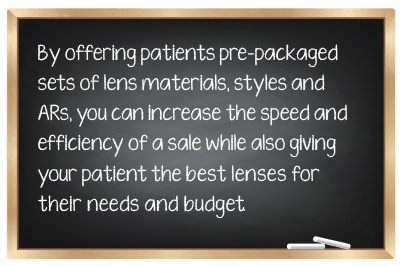
By Preston Fassel
Perhaps it’s a bit clumsy of a metaphor, but there’s a great deal of truth to what he says. From a fast food menu that’s too big to streaming services’ seemingly endless array of movies and TV shows, too many choices can leave a person stymied and unable to make any choice at all. The same holds true in the realm of opticianry, especially for a patient not well-versed in optics, choosing the right pair of lenses with myriad materials, treatments, PALs and other features can leave them at a loss for what’s the right choice. Of course, it’s one of the optician’s roles to advise and counsel every patient on the best possible choice for them, but deep-dive one-on-one rap sessions into the world of optics can be overwhelming for both parties. This is why coming up with a set of lens packages for your practice can be a quick, efficient way of conveying to patients what the best choices for them may be, both in terms of suitability and in price point. By offering patients pre-packaged sets of lens materials, styles and ARs, you can increase the speed and efficiency of a sale while also giving your patient the best lenses for their needs and budget. While it’s up to every individual practice to determine the best lens packages for their clientele, here are some suggestions for a set of packages that can help you simplify the selection process for your patients.
THE BASIC
Components: Single vision, poly, standard AR
It’s important to have a basic set of lenses as part of a package deal for a number of reasons. Many first-time glasses wearers will be hesitant to spend a lot of money on something they’ve never experienced before, while other patients will simply be unable to afford anything else. By packaging SV poly lenses with a standard AR, you’re covering numerous bases and achieving a number of goals. It’s the perfect combination for first time lens wearers, especially children, as poly is impact and UV resistant, and the AR will eliminate glare either in the classroom or the office. It’s simultaneously a good starter lens package for children and first timers, and also a reliable combination for individuals unable or unwilling to pay more. Because you can get this combination as a stock lens, for practices with their own edger, it also means a good profit point. If your practice offers frame and lens combos, this is also an excellent package to offer as part of a deal with a pair of bargain/discount/clearance frames.
THE OLD-TIMER
Components: Flattop 28, poly, standard AR
I once worked in a finishing lab where another employee constantly derided bifocal wearers as “a bunch of idiots” for not wearing PAL lenses and who went out of his way to discourage accounts from placing bifocal (BF) orders. The fact of the matter is that many patients—especially older ones who’ve only ever worn flattops—prefer the bifocal lens, either because they can’t/won’t adjust to PAL lenses, can’t afford them, or are just so used to wearing them that they don’t want to make a change. The practice that I worked at for the majority of my career did healthy PAL sales, but we also serviced a clientele of older patients who had begun wearing BFs for a significant portion of their lives. Of course, you can educate every patient requiring a multifocal in the benefits and advantages of PALs, but for that 70 year old guy who you know just isn’t going to change, a BF package is imperative. Many older patients will also want a simplified lens selection process so as not to become overwhelmed by information they consider irrelevant—they know what they like, and they want to stick with it—so offering them this package is a sure way to make their visit fulfilling and stress free. As with the basic package, the poly is advantageous because it’s impact resistant, providing some extra security in a population prone to falls. The AR will also help eliminate glare and provide better vision for patients whose eyesight have begun to deteriorate or who may be in the pre-cataract stage.
THE STANDARD PAL
Components: Basic PAL, poly, standard AR
The standard PAL package fulfills many of the same purposes as the standard SV package. Just as many patients new to glasses will be apprehensive about investing a lot of money into a new experience, even lifelong wearers may be hesitant to make the leap into a higher-grade (and higher cost) PAL the first time they’re prescribed it; other PAL wearers still may not be able to foot the bill for digital PALs. Just as it’s important to offer these first-timers/lower-income patients the opportunity to “test drive” a set of lenses for at least a year and adjust to the experience, it’s important to offer first-time PAL wearers the same. Extra caution needs to be taken though, in selecting what basic PAL you’re offering—this will be the lens that sets the standard for your patient’s experience and which may determine whether they become happy lifelong PAL wearers or struggle with different types of multifocals or awkwardly switching between multiple pairs. Not all PALs are created equal, and this is especially true when choosing from among lower cost, more basic designs. Make sure that you’re selecting an inexpensive but nevertheless reliable PAL with a good reputation for easy adaptation and ensure that your lab is experienced in edging it properly, or that your own in-house edger is comfortable with cutting stock lenses accurately. Remember: inexpensive but never cheap. By offering first-time PAL wearers or those unable to afford higher grade designs a package, you’ll be un-complicating what can be an overwhelming experience and potentially priming them to make a better investment next year. Again, we’re going with poly and standard AR.
THE SPORTSMAN
Components: Poly, mid-range AR, photochromic lenses
Many patients, from high school ball players to weekend sportsmen (and occasionally professional athletes—one of my old patients was a pro-tennis player) will need to pick up a second pair of frames for use on the field, court or course. While some of them may be in a position to make a higher investment in a pair of sport glasses, for most, this will be a second pair purchase after they have already put money into a primary pair of glasses. Packaging together a sports lens both takes the financial pressure off and also eases the process of selecting lenses that will be especially prone to damage in a high-stakes environment. As with the other packages we’ve discussed thus far, poly is the way to go, offering patients a UV and impact resistant lens at a lower price point; unlike previous lenses though, a mid-range AR is the best selection, as it will offer patients a higher level of clarity outdoors, while also offering the benefits of higher grade ARs such as hydrophobic and oleophobic coatings, which will help keep the lenses cleaner and clearer during outdoor activity. A photochromic lens is also highly recommended: This will provide the patient adequate sun protection in a variety of environments, while also doubling as “clear glasses” during later evening or nighttime games. At my old practice, our high school baseball players (and their parents) especially embraced this lens package. If your supplier offers it, I recommend using a brown photochromic, which in my experience benefits the widest number of athletes: it offers a higher level of contrast and better ability to locate lighter colored balls against green grass and was the preferred lens color for my baseball players, golfers and tennis players. To make things even simpler on your patients, I recommend bundling this lens with a few general-purpose sport frames to offer a “complete” package. There are a number of sport frames on the market that fit a wide variety of head shapes and sizes of all ages, and which suit almost every sport; offering complete “sport frame” sets to patients makes the process all the easier.

THE CADILLAC 1.0
Components: SV, Trivex, high-end AR, photochromics
We’ve discussed a number of situations up until now that take into consideration patients being unable or unwilling to pay for higher quality lenses. How about the patient who knows what he or she likes and wants to drop the money to get the very best? Well, give it to them: The Cadillac Package combines the very best in SV lenses, from the lightweight, impact-resistant ultra-clarity Trivex to a top-level AR offering the best additional scratch resistance, oleophobic and hydrophobic properties, and photochromics for comfort regardless of the environment. Note that if you’re going to offer this as part of a frame package, you should choose to pair it with higher quality frames than you might choose for some of the more basic options: There’s no point in dropping a brand new V8 engine into a used Smart Car, and it’s defeating some of the purpose to put these lenses into your low-cost bargain frames. If a patient is willing to spend the money on this package, he or she should have a pair of frames to match the quality—and odds are, they’ll be happy to pay that little bit extra for the total package.
THE CADILLAC 2.0
Components: Digital PAL, trivex, high-end AR, photochromics
So I’ve run out of names. The point stands that you should have a PAL equivalent package to match the SV “Cadillac” option. As with your bargain PAL package, extra care needs to be placed into which lens you choose to offer. Patients paying for a top of the line bundle are going to expect the very best and especially with a PAL, it needs to be the very best. One mistake not to make is to associate the cost of a digital PAL with quality—in my own experience, I discovered that my patients adapted easier, faster and had a better quality of vision and higher overall satisfaction with a digital PAL from our manufacturer that they considered “two steps down” from their “top of the line” lens. Similarly, the lens that they considered to be their “very best” had a fairly high level of patient dissatisfaction. In my experience, this has been due to the highest cost PALs also being some of the newest, meaning labs haven’t had the opportunity to get the kinks out of the design or get reliable patient feedback. Slightly less expensive lenses, meanwhile, were yesterday’s top of the line that have been “downgraded” in the wake of new technology. With a lower price point and longer track record, these are the PALs to look at to offer your patient the very best in quality and experience while also making a healthy profit for yourself.
All of these packages are only suggestions, and it’s ultimately up to you to determine what combinations will best suit your practice needs and patient demographics. It’s also important to remember that package sales aren’t for every patient—especially in an Internet age where customization is king, many people, particularly Millennials, will want the opportunity to pick and choose every component of their lenses, from material to AR. It’s important to identify these patients and allow them the experience. For others though, package deals will send patients on their way, happy that a difficult decision was made a lot simpler. ■
Preston Fassell is an award winning author, journalist and optical consultant. He has been a contributing editor for 20/20 Magazine since 2012.












